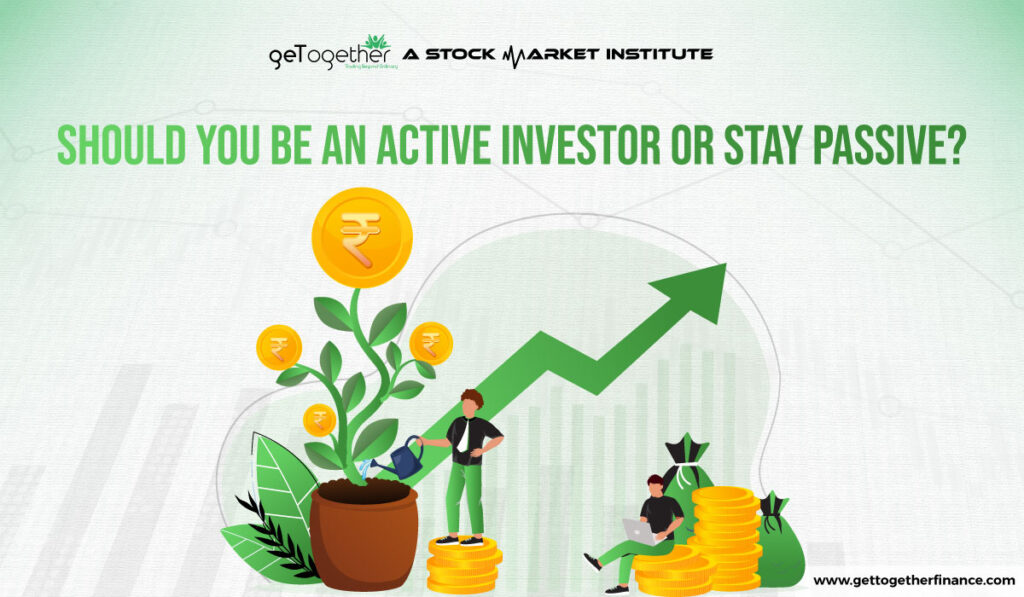Should You Be an Active Investor or Stay Passive?
- July 9, 2024
- 1588 Views
- by Manaswi Agarwal


Investors might get confused with the strategies that they should adopt for investment purposes. Portfolios can be managed either actively or passively which is completely dependent on your personal circumstances, preferences and goals. Investors must be very clear about their risk tolerance, investment knowledge and financial goals while dedicating enough time to manage the investments. This blog will help you get rid of the confusion of being an active or passive investor.
Active Investing
Active investors are regularly involved in the market where they actively manage their funds with the perspective of maximizing their returns. Active investors build efficient market skills as well as employ multiple techniques to analyze their perfect entry or exit points. The goals of active investors are to beat the market through a hands on approach and outperform certain benchmarks. An active investor aims to generate better returns as compared to mutual funds or banks.
Pros of being an Active Investor

Many fund managers in large institutions actively manage a significant portion of their client’s portfolios. This allows managers to keep the holdings in place which is performed by segregating funds into mutual funds, exchange traded funds, stocks, bonds, and other assets. Lets us go through some of the main advantages of being an active investor:
Flexibility
Active investment strategy offers flexibility to the traders to make informed decisions because they are not required to hold stocks or bonds for a long time. These investors can make quick investment decisions as per market movements.
Risk Management
An active investor uses suitable trading techniques to maximize their returns and at the same have the capability to manage the losses. They are able to get out of specific holdings when the risk is too high.
Hedging Strategies
In order to manage risks and losses, active investors make use of hedging strategies such as short sales, put options and other strategies to avoid losses.
Potential Higher Returns
Active investors can gain higher returns as they keep regular market updates and pick the stocks through strategies at the best time.
Cons of an Active Investor

Active investment is not a smooth path to walk on, apart from their benefits; investors should be well prepared for various risks and challenges. Here are some of the disadvantages of being an active investor.
Also Read: Non Institutional Investor
Time Consuming
Investors who are regularly engaged in investing or trading have to dedicate enough time for research, analysis as well as monitoring the market.
Costs
Active investors have to incur higher transactions as their frequency of trades is also higher. This can lead them to pay high transaction fees, taxes, and management costs.
High Risk
Market is quite volatile in the short term which obligates active investors to look up to several risk mitigating measures as high risks come with great losses when it is not managed properly through stop losses.
Passive Investors
Passive investing is a long term investment approach to holding investments. In simple terms, passive investing is a buy and hold strategy with minimal trading in the market. It is mainly done with index funds to avoid the losses of individual assets. The focus of passive investors is to generate stable returns over time with a goal to build wealth gradually.
Pros of Passive Investing

Simplicity
Investing in funds is one easier strategy to implement for investors by avoiding huge losses. Passive investing offers simplicity as it doesn’t require an individual to indulge in complex regular trades. Investments are simpler to manage with less time commitment.
Low Costs
Trading volume is low while managing passive funds for investors which is why an individual investor does not have to pay a large amount of cost related to management fees, etc. Moreover, fewer transactions in a portfolio ensure reduced tax implications for passive investors.
Diversified Risks
Passive investors acquire broad market exposure which reduces their risk as compared to individual stock pricing.
Cons of Passive Investing

Less Flexibility
Managing funds passively offer less flexibility to the investors with no planned exit strategies during market volatility. Passive investors are not flexible to respond to market fluctuations quickly and intellectually.
Limited Exposure
Passive investors do not get to enjoy moves of single assets as their funds are limited and locked in long term opportunities. This makes investors lose short term opportunities which sometimes limit their exposure towards opportunities having greater returns.
Active Investing Vs Passive Investing

To adopt a fine investing approach as an individual, it is essential to know the basic difference of the two approaches. Know the difference between the two strategies to make informed investment decisions:
| Basis of Difference | Active Investment | Passive Investment |
| Strategy | Buy and Sell | Buy and Hold |
| Fund Management | Funds are managed actively | Passively managed funds |
| Risk | High Risk | Less Risk |
| Flexibility | More Flexible | Less Flexible |
| Time Consumption | More time consuming | Less time consuming |
Key Determinants of Investing Approach

To make the best choice and investment strategy, an investor should be aware of some factors based on which informed decisions can be taken and risks can be reduced.
Time
Your investment approach must be based upon the time that you are ready to commit towards the market. If you have other things going on; it would be much better to avoid an active investment approach because one wrong decision can result in huge losses.
Risk Tolerance
You should adopt the investment approach according to the risk you are willing to take in the market. If you can take a high amount of risk with appropriate knowledge, active investing could be a great option, otherwise passive investing can be done with financial advisors.
Analytical Skills
Knowledge is one important factor to step into the market. If you have great technical and analytical skills, an active investment approach can prove to be beneficial. If you have a lack of knowledge then, you can join GTF- Trading in the Zone course which can help you be an active investor by giving you the required skills.
Final Thoughts
Now that you have understood the pros and cons of being an active or a passive investor, you can easily choose the mode of investment as per your strategies. On the other hand, GTF Trading in the Zone course allows you to make informed decisions.
FAQs
What is Active Investing?
Active investment is an approach used by investors who are actively engaged in the stock market to maximize their returns. They employ many investment techniques and strategies to buy and sell the assets at best prices.
What is Passive Investing?
Passive investing is a long term investment approach where usually an investor buys an index fund or ETFs to avoid fluctuations of individual assets. In passive investing, investors aim to generate stable index returns.
Is it better to be an active or passive investor?
You should firstly analyze your risk tolerance, knowledge, analytical skills and various other factors before you pick an investment strategy. Both strategies have several pros and cons which are suitable for investors in different way.
What is an active investor example?
An investor who frequently initiates trades and constantly monitors the market with a goal of outperforming the index; a hedge fund manager can be a great example of an active investor.



 Instagram
Instagram 
